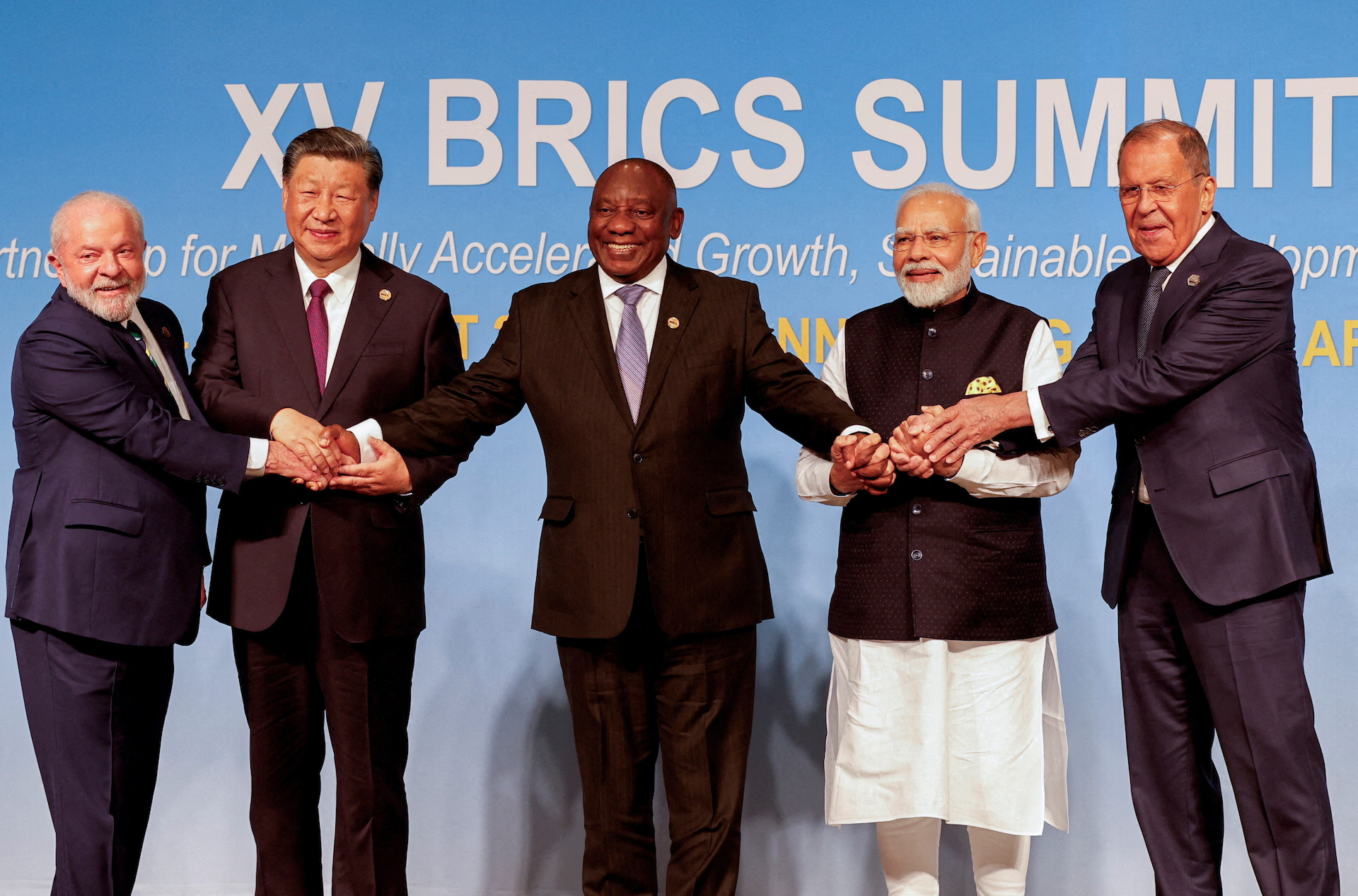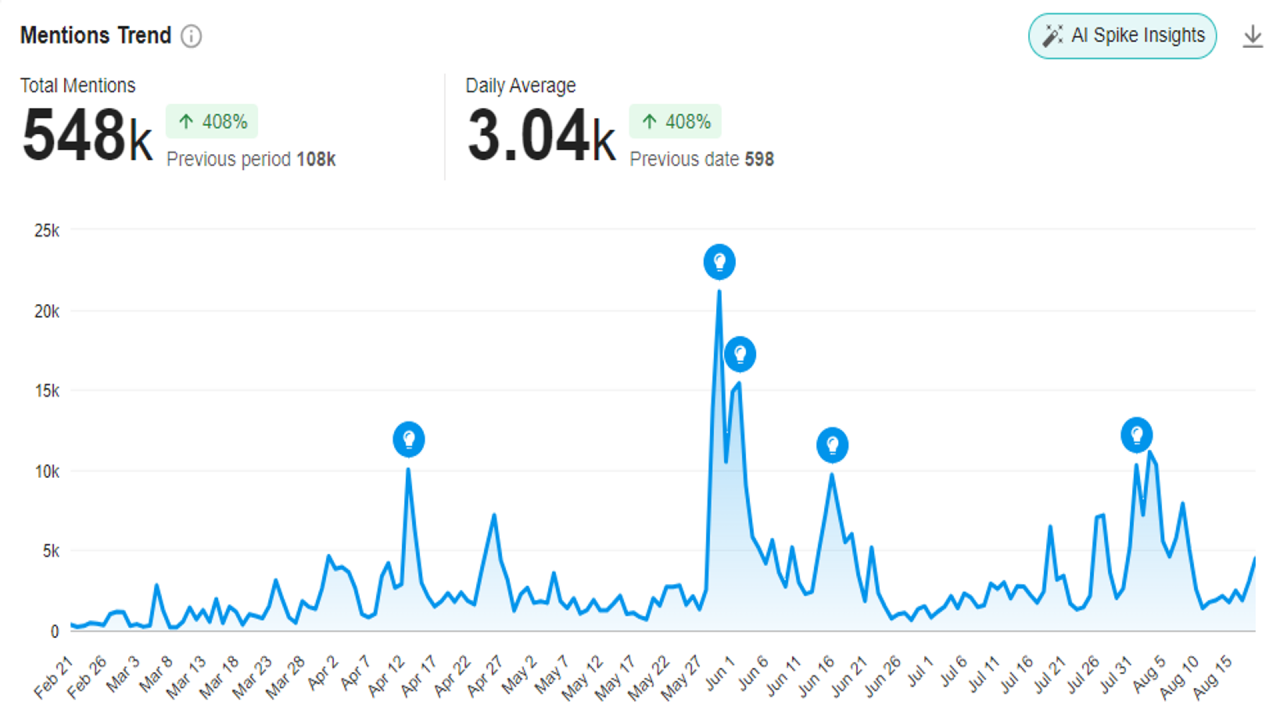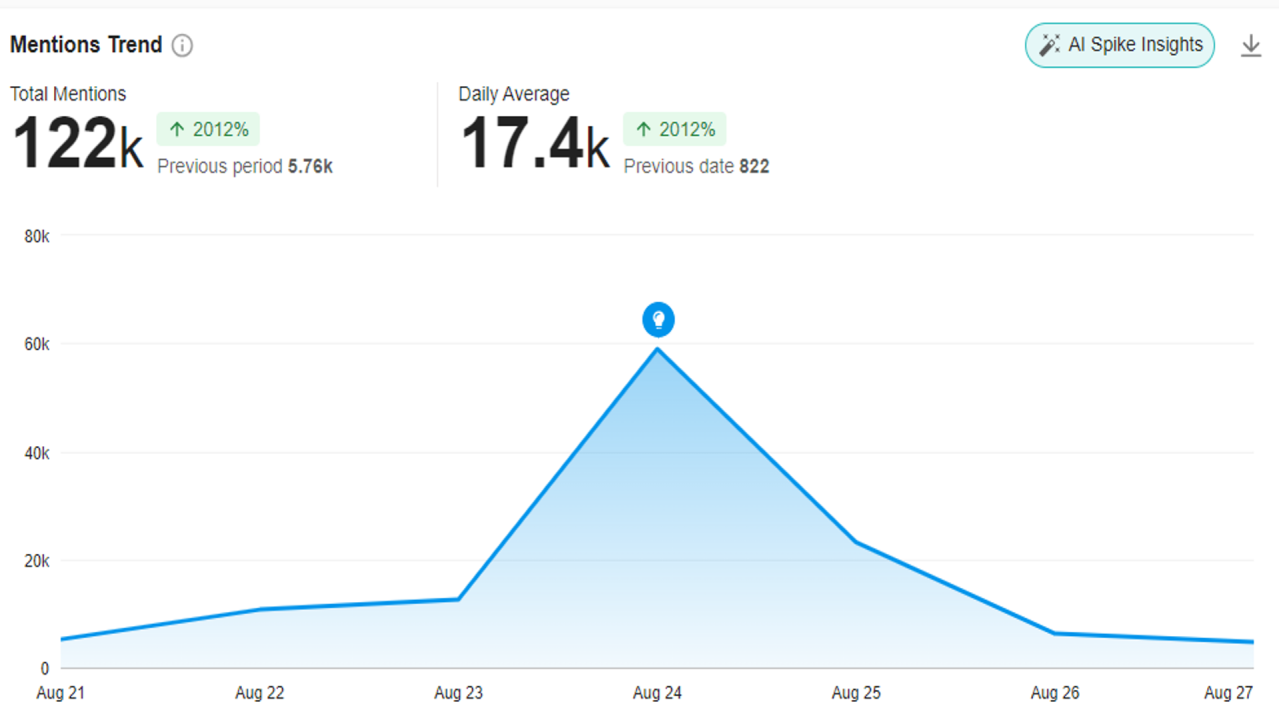Pro-Russian BRICS narratives in Latin America prospered during summit lead-up
In the six months ahead of the BRICS summit, narratives about a new multipolar world and the fall of US hegemony trended in Spanish-speaking Latin America information space
Pro-Russian BRICS narratives in Latin America prospered during summit lead-up

BANNER: President of Brazil Luiz Inacio Lula da Silva, President of China Xi Jinping, South African President Cyril Ramaphosa, Prime Minister of India Narendra Modi and Russia’s Foreign Minister Sergei Lavrov pose for a BRICS family photo during the 2023 BRICS Summit at the Sandton Convention Centre in Johannesburg, South Africa, on August 23, 2023. (Source: Gianluigi Guercia/Pool via Reuters/File Photo)
In the six months leading up to the August 2023 BRICS Summit, narratives related to the bloc’s expansion spread throughout Latin America across the Spanish-language information space.
Media outlets and social media accounts associated with Russia and Venezuela, and to a lesser extent China, positioned the BRICS partnership – a multilateral economic cooperation group comprised of Brazil, Russia, India, China, and South Africa – as the platform to reorganize international affairs into a multipolar world that would replace US hegemony. Likewise, these actors propagated narratives about the supposed de-dollarization of the world economy and the imminent creation of a unified BRICS currency that would replace the dollar as the main instrument for global exchange. The DFRLab observed similar narrative trends in Brazil published in Portuguese.
The idea of building a multipolar global order has been a long-time aspiration in Latin America. The topic was central to the political tenets of the Latin American left that gained influence across the hemisphere in the early 21st century when left-wing governments held power in most of the region. In the last two years, narratives spread by state media from authoritarian countries, their proxies, and social media assets have emphasized that the common interests between Russia, China, Africa, the Middle Eastern, and Latin America are leading toward multipolar geopolitics that will replace the unipolar world dominated by the United States. Now, the BRICS bloc is portrayed as the space in which such a multipolar world is gaining momentum.
A multipolar, de-dollarized world
The DFRLab identified two primary narratives related to the BRICS propagating in Spanish between February 21 and August 20, 2023. The first narrative centered on the idea that the world economy is facing a process of de-dollarization, contributing to the fall of US hegemony. According to a query using the social media monitoring tool Meltwater Explore, 66,700 social media posts focused on this narrative, including 3,535 posts that also referred to the mineral wealth of the Latin American countries applying to join BRICS. The second narrative claimed that BRICS expansion signals the consolidation of a new multipolar world order. According to a Meltwater query, 50,203 social media posts focused on this topic, with more than 2,000 of them highlighting the decay of the US hegemony.
The DFRLab also examined publications on Spanish-language state media websites from Russia, China, and Venezuela discussing BRICS consolidation and expansion. RT en español, Russia’s Spanish-language edition of its RT news outlet, stressed in its BRICS coverage the interest of various countries in the Global South in joining the emerging bloc. It highlighted that the US dollar is losing prominence, raising the possibility of BRICS issuing its own global exchange currency. RT also conveyed the Kremlin’s support for Latin American countries that maintain friendly relations with Russia joining the bloc, including Argentina, Bolivia, and Venezuela, and emphasized the consensus among the five current BRICS members on the bloc’s role in a multipolar world and the benefits of potential expansion. Sputnik Mundo, another Spanish-language Russian state outlet, also emphasized the multipolar world narrative in its coverage of BRICS.

Venezuelan network TeleSUR gave ample coverage to BRICS expansion, the prospect of global de-dollarization, and the supposedly emerging new geopolitical order. TeleSUR coverage boosted Venezuela’s interest in joining the bloc and the support gained from Brazil, China, and Russia. The United Socialist Party of Venezuela (PSUV) expressed similar views on posts to its official webpage.

Xinhua Español also dedicated coverage to BRICS expansion. Interestingly, mentions of Russia were absent in Xinhua’s headlines about BRICS during the analyzed period. From the newswire’s perspective, China is the motor driving BRICS, while the rest of the members are collaborators in building a multipolar model. In its news in Spanish, Xinhua highlighted Brazil’s actions promoting the bloc’s growth. Likewise, it covered Venezuela’s and Argentina’s interest in joining the bloc positively. Nonetheless, Xinhua Español did not receive as much amplification on social media as Russian and Venezuelan media did.

Pro-Kremlin and Venezuelan assets drive the conversation about BRICS in Spanish
Using data aggregated through the social media monitoring tool Meltwater Explore, the DFRLab analyzed BRICS-related social media trends and conversations over the six months leading up to August 2023 summit. Trends on the topic corresponded with newsworthy events and related posts on social media. During the period from February 21 to August 20, the word “BRICS” appeared on 547,966 Twitter posts in Spanish posted by accounts located in Latin America, averaging 3,044 posts daily.

On four days during this period, the term “BRICS” surpassed 10,000 mentions. While newsworthy events affected the timing of when the topic trended, three of the observed peaks were driven partially in a coordinated fashion by the Venezuelan government.
On May 30, Brazilian President Lula Da Silva declared his support for Venezuela’s entry into the BRICS and for a new common currency for commercial exchange among the bloc members. Lula’s statements occurred during a meeting of South American presidents to relaunch the region’s integration agenda. Venezuelan social media assets (accounts, pages, etc.) used the hashtag #Renacimientodelsur (“The South Renaissance”) in combination with #BRICS in reference to the presidential meeting and Lula’s statements. The hashtag appeared in 410,000 tweets posted between May 29 and June 2. The Venezuelan Ministry of Communication and Information posted the most engaged-with tweet, when it announced its etiqueta del día, a “daily hashtag” backed by monetary incentives, on May 30. Besides Venezuelan accounts, the hashtag was shared by accounts located in Cuba, Spain, the United States, Nigeria, Mexico, Brazil, India, Norway, and Colombia.
On June 2, the BRICS member countries announced that they had agreed to discuss a common currency. Venezuelan social media assets associated the BRICS currency with global de-dollarization and their hashtag campaign #VenezuelaSinSanciones (“Venezuela Without Sanctions”). According to a Meltwater query, the hashtag appeared in 395,000 tweets, mostly between June 2 and June 5. Once again, the Venezuelan Ministry of Communication and Information posted the most engaged-with tweet for the hashtag, in its daily hashtag for June 2. Besides Venezuelan accounts, accounts located in Cuba, USA, Mexico, Nigeria, Spain, Colombia, Brazil, Norway, and the Dominican Republic also shared the hashtag.
Between February 21 and August 20, accounts located in Latin America posted the hashtag #BRICS over 64,000 times. The top countries by number of hashtag users were Brazil, Venezuela, Mexico, Argentina, Cuba, Colombia, Ecuador, Chile, Peru, and Bolivia. Beyond the hashtag itself, overall mentions of the word “BRICS” peaked on August 1, driven by conversations related to Bolivia’s request for membership and the announcement of Colombia being invited to participate in the South Africa summit.

On June 16, topic mentions were fueled by an RT en español piece that resurfaced late Venezuelan President Hugo Chávez’s 2006 speech to the United Nations. In that speech, Chávez challenged US imperialism and, according to RT en español, prophesized the emergence of the BRICS. Pro-Kremlin assets amplified the piece and the video on Twitter, generating social media buzz about BRICS as a multipolar insurgency against the United States. According to a query using social media monitoring tool BuzzSumo, the link to the RT en español piece was posted by 279 different accounts on Twitter and 239 accounts on Facebook. The RT piece was reshared in several outlets in Latin America, especially outlets directed to audiences in Argentina and other countries in southern South America.

According to a BuzzSumo search, the most shared links to BRICS stories on Facebook and Twitter were primarily to articles favorable to the bloc expansion. Several stories from Russian-state media appeared among the most shared BRICS links. However, stories from non-state media such as CNÑ (CNN in Spanish) and Colombia’s SEMANA topped the list, according to the BuzzSumo results.

Two of the most shared news stories about BRICS on social media referred to Argentina’s affiliation with the bloc’s bank and mentioned current Argentinian Minister of Economy Sergio Massa, the ruling Peronist party’s candidate in the presidential election scheduled for October 2023. At the BRICS summit, Argentina – along with Iran, Saudi Arabia, the United Arab Emirates, Egypt, and Ethiopia – was formally invited to join the bloc in January 2024. However, Argentina’s decision to join could depend on whether the ruling center-left party, which came third in the primary polls on August 13, manages to win the upcoming presidential election, as it is the only party to have expressed support for the move.
During the week of August 21, which coincided with the summit, the term “BRICS” appeared in nearly 122,000 Twitter posts in Spanish by accounts located in Latin America, averaging more than 17,000 posts daily. During that week, the conversation focused on BRICS expansion, with most tweets originating from accounts in Argentina, Venezuela, Mexico, Cuba, and Colombia.

Although the accession of the oil-producing countries Iran, Saudi Arabia, and the United Arab Emirates stood out internationally, the potential accession of Argentina generated more interest among Latin American audiences. The debate on social media focused on the relationship between the continuity in the government of the populist Peronist party and Argentina actually joining BRICS. Both libertarian right-wing Javier Milei and center-right Patricia Bullrich expressed disagreement with joining an organization led by China and Russia. The three tweets in Spanish referring to the BRICS that generated the most engagement during summit week stated the position of the three Argentinian political parties with a chance of winning the upcoming presidential elections.

Content related to the rise of the BRICS also appeared in YouTube channels in the months ahead of the summit, with the most popular videos favoring de-dollarization and the creation of the bloc’s digital currency for global exchange. Pro-Kremlin YouTube channels seemingly based in Mexico posted the most popular content in Spanish discussing BRICS.

After the BRICS summit ended, RT en español continued to propagate the narrative of an historic change in world geopolitics due to the bloc’s expansion.

Iranian Spanish-language outlet HispanTV also adopted the narrative of the rise of the multipolar order with the expansion of BRICS and the decline of US hegemony.

In the lead-up to the BRICS summit, Russian, Venezuelan, and Chinese social media assets framed the meeting as an historic geopolitical turn. For Latin American audiences exposed to these networks, the BRICS summit was portrayed as the start of a new world order built by the alliance between the East and the Global South against US imperialism. It is not yet known how much actual geopolitical impact BRICS expansion will have. And despite the narrative buzz about de-dollarization, there was no formal discussion on the creation of a common BRICS currency during the event. The bloc’s finance ministers are assessing the use of local currencies for trade, as well as the feasibility of setting up new payment platforms. Their reports are expected to be on the table for discussion at next year’s summit, which will take place in Russia.
Cite this case study:
Iria Puyosa, “Pro-Russian BRICS narratives in Latin America prospered during summit leadup,” Digital Forensic Research Lab (DFRLab), September 6, 2023, https://dfrlab.org/2023/09/06/pro-russian-brics-narratives-in-latin-america-prospered-during-summit-lead-up.

